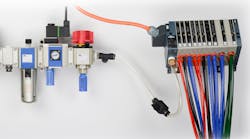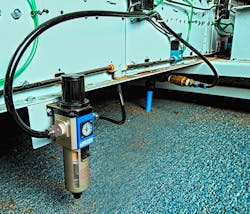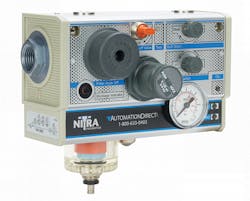Air preparation is a fundamental, yet often underappreciated, aspect of pneumatics. “Air prep,” as it is often called, can seem unimportant or just adding needless upstream complexity. The reality is air prep ensures downstream devices get the correct air cleanliness, pressure and lubrication.
Here are some tips on how engineers can design or specify air prep subsystems that make sure pneumatic equipment performs at its best for many years, cuts maintenance costs and reduces downtime.
Pneumatic Design Basics
For any pneumatic components, port sizes must be matched to the inlet and outlet piping or tubing. Additionally, pneumatic devices can be rated for a normal operating pressure range—sometimes a proof pressure, possibly a burst pressure and perhaps all three.
A device’s operating pressure is what is takes to operate properly. For example, a solenoid valve may have an operating pressure range of 20 to 100 psi. Too little or too much pressure means there is no guarantee the valve will operate correctly or at all.
Proof and burst pressure ratings are a little trickier. Proof pressure is the maximum air pressure a device can handle before it may fail and no longer work, even if proper pressure is restored. Burst pressure is the maximum pressure the device will take before it may fail catastrophically, which can pose a danger to personnel and cause other equipment failures.
System Disconnect
Before addressing specific air prep concepts, it is prudent to consider methods of disconnecting the air prep equipment. The ability to remove hazardous energy from machinery that is not in use or when maintenance needs to be performed is crucial. OSHA and ANSI consider compressed air a hazardous energy source, so provisions must be made to isolate downstream components from the source, bleed (or remove) downstream pressure and lock the system in this state to protect against inadvertent re-energization.
Manual shut-off relief valves are the basic pneumatic disconnect component for isolating downstream equipment from the upstream, and will also bleed or “relieve” downstream pressure. Most manual shut-off valves have much higher operating pressure ranges than other pneumatic devices.
A more advanced disconnect component is the isolation/lockout valve. These valves are analogous to an emergency stop device in an electrically controlled machine. Isolation/lockout valves are installed upstream of systems to be protected, and when activated, they disconnect incoming air pressure. They are similar to shut-off relief valves but have larger ports so they can release air from the downstream much faster. This quickly puts the downstream pneumatics into a safe state. Isolation/lockout valves can be locked in the “off” state.
An optional component which may be used with a manual shut-off valve is a soft-start valve. Soft-start valves are activated with an electrical signal and they gradually ramp up downstream pneumatic pressure. When the electrical signal is removed from the valve, it acts as a quick-dump valve, disconnecting upstream supply air and quickly removing pressurized air from the system.
Air Filtration
Even with proper pressure, contaminants in the airstream can wreak havoc on a pneumatic system over time. Millions of particles of dust, dirt, sand, oil and water can be found in a cubic foot of compressed air, and sometimes even worse things such as metal particles. This makes proper filtration the unsung hero for preventing downtime due to contaminants.
Passive air filters come in two basic designs: centrifugal and coalescing. Centrifugal is more commonly seen and is good for removing most dirt and metal particles, as well as some water. They work by circulating the air and trapping contaminants in the filter as they pass around it.
Coalescing filters are typically used along with a centrifugal filter when more stringent filtration is needed. Coalescing filters excel at removing fine mists of moisture and oil. They filter them out by passing the air through the filter element to trap droplets of contaminants.
Both filters collect some moisture, even from the driest compressed air. Moisture or water collects in a bowl at the bottom of these filters, which needs to be drained periodically using one of three types of drains: manual, semi-automatic and automatic. Manual drains require human intervention to operate; semi-automatic drains operate every time air pressure is dumped from the system; and automatic drains empty when the bowl is full.
Some compressed air supplies contain significant moisture, requiring more than passive filtration. These systems may need an active dryer, which usually needs electrical power. Active dryers for air prep may be one of three types: refrigerated, desiccant or membrane. Each works on a different principle, but all three are large compared to other air-prep components. Active dryers add to the cost and complexity of air prep, but sometimes are an unavoidable necessity.
Getting the Right Pressure
Although air filtration is the first step in air prep, establishing proper downstream air pressure is usually considered air prep’s most important aspect. Upstream pressure is usually generated and maintained at a higher level for distribution and must be stepped down to the proper operating pressure using an air pressure regulator.
Air pressure regulators have an input (high side) and an output (low side) and will not work if installed backward. Most regulators come with a built-in gauge so operators can see the exact value being supplied to the system at the downstream/low side of the regulator.
Just like downstream pneumatic components, regulators have operating, proof and burst pressure ratings which must be compatible with high side conditions and the low side requirements. Regulators can be specified within a standard range or as precision regulators. Precision regulators allow much finer tuning of output pressure, useful if downstream devices are sensitive to the operating pressure range.
To save space and overall cost, some designers opt for a filter/regulator combination or a total air preparation (TAP) unit. Filter/regulator units combine the two functions into one component, which saves space but may not have all of the features or specifications designers could get from two separate units. A TAP unit is even more comprehensive, combining a filter, regulator and manual shut-off valve in one compact unit. Sometimes a soft-start valve is also available. When they meet the needs, TAP units minimize design work, save footprint space and cut total installed costs.
Air Lubrication
Most modern pneumatic components simply need clean dry air to work properly. However, some older devices or air tools still need proper lubrication be added to the compressed air. Moving parts and seals in some pneumatic devices need to be lubricated. For example, devices such as cylinders and valves require proper lubrication to prevent leaks, rust, premature wear and seizing.
Pneumatic lubricators can be installed downstream of all other air prep devices. They inject a controlled fine mist of the proper oil type into the clean dry air. The amount it injects can be fine-tuned to precisely meet downstream needs. Because not all devices require lubrication, lubricators are most often installed just upstream of and close to the devices that need it.
Putting it All Together
The normal installation order, from upstream to downstream, of pneumatic air preparation devices is:
- System isolation valve
- Filter
- Regulator
- Lubricator (if needed)
- Device shut-off valve
Users can select the exact right combination of devices needed for their application. Because filtration is typically upstream of regulation, the filter needs to be rated to handle the supply air pressure. TAP units are a useful way to get most of these functions, other than lubrication.
Air preparation is not complicated but is easy to neglect compared to the more active downstream aspects of pneumatics, such as automatic valves and actuators. In all cases, ensuring proper air preparation is in place leads to years of safe and trouble-free pneumatic operation.
Kevin Kakascik is a technical marketing engineer at AutomationDirect.
This article is part of Power & Motion's Fundamentals of Fluid Power: Pneumatics ebook; download the full guide to learn about the latest technologies and design methods for developing modern pneumatic systems.




